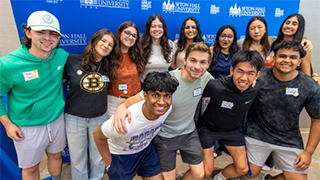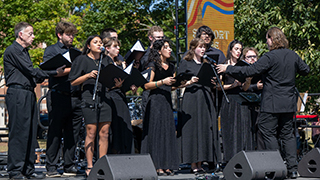Seton Hall’s 'Hidden Treasures' on Display: Augmented Reality Storytelling Brings Seton Hall History to Life
Thursday, November 9, 2023

The exhibit restores the Seton Hall Bell, now on display in the Special Collections Reading Room, to its original location in Mooney Hall.
The use of augmented reality technology, or "AR", is on the rise at universities across the world, and Seton Hall’s Walsh Gallery is at the forefront. Library and museum staff are using AR to help the Seton Hall community learn more about University history on a campus exhibit called "Hidden Treasures". Launched on Seton Hall Weekend, the exhibit locates 3D images of objects housed safely in the Gallery and Archives & Special Collections in meaningful spots across campus.
Using Membit, an augmented reality story-telling platform co-founded in 2014 by tech innovator Jay Van Buren, one can "leave" a 3D object, an image, or a video in a real location, prompting those keen to play hide-and-seek to embark on a learning trail - a sort of digital scavenger hunt reminiscent of games like Pokemon Go. Hidden Treasures, the creation of Gallery Director Jeanne Brasile, prompts virtual learning.
 "The genesis of Hidden Treasures dates back to a project I had worked on as an independent
curator in Newark," said Brasile. "It was in a gallery called Index Art Center… a
show called Making Time, which I curated back in 2019. One of the artists, Shuli Sade,
created a series of 11 augmented reality pieces, to be in that show, but none of the
pieces were physically present." Instead, the works were hidden around the gallery
virtually using augmented reality, which one could see using an app from a certain
vantage point in the gallery. That app was Membit.
"The genesis of Hidden Treasures dates back to a project I had worked on as an independent
curator in Newark," said Brasile. "It was in a gallery called Index Art Center… a
show called Making Time, which I curated back in 2019. One of the artists, Shuli Sade,
created a series of 11 augmented reality pieces, to be in that show, but none of the
pieces were physically present." Instead, the works were hidden around the gallery
virtually using augmented reality, which one could see using an app from a certain
vantage point in the gallery. That app was Membit.
Brasile began to consider how she could bring Membit to Seton Hall and integrate some of the pieces in the university’s collections. About a year ago, University Libraries, in partnership with TLTC, acquired a 3D scanner to capture delicate artifacts, which could be used for augmented reality as a virtual way of expanding their use and possibilities for students and faculty to interact with the art and artifacts.
"We started thinking about ways to connect the collections with places on campus that would enhance their meaning or explain their use or context a tiny bit more," Brasile said.
 Among its many uses, Membit can help safely (and virtually) bring rare and carefully
preserved archival collections and gallery exhibitions outside of their protective
walls and vaults, and into the sightlines of students and faculty. Membit has been
used to do augmented reality storytelling for years in the arts, culture, and technology
industries, but it has more recently begun to catch the eye of university-based museum
professionals like Ms. Brasile.
Among its many uses, Membit can help safely (and virtually) bring rare and carefully
preserved archival collections and gallery exhibitions outside of their protective
walls and vaults, and into the sightlines of students and faculty. Membit has been
used to do augmented reality storytelling for years in the arts, culture, and technology
industries, but it has more recently begun to catch the eye of university-based museum
professionals like Ms. Brasile.
"When you bring objects into proximity with reality like trees or buildings or people, they take on new resonance," she said. The objects, which she selected alongside Collections Manager Laura Hapke, began to take shape as a campus trail. "We thought about situating things on the perimeter of the green since that seems to be…an area where a lot of student activity and programs or special events take place. And then, we thought about the history of the buildings and objects that might illuminate that history or play into the context of the building."
 The exhibit includes key objects from university history such as the Seton Hall Bell,
which once heralded the start of school at Seton Hall Prep, based in Mooney Hall.
Browsing the tour in Membit, when arriving at Mooney Hall viewers will be able to
click on the app when they are ready to view the image and it will appear, superimposed
over the real camera image of Mooney Hall – bringing the past to life. Other objects
in the exhibit include Sister Rose Thering’s B’nai B’rith Award, a chalice, an amphora,
a tripod vase, a Japanese toy tiger, the WSOU 33 ⅓ record, a medal from Mother Seton's
canonization, an original sketch of the Seton Hall University Coat of Arms, and a
photograph of Congressman Donald Payne ‘57, the first African American congressperson
from New Jersey. "This exhibit shows how we can bring these objects and images out
of our walls, onto campus, so people can see them in a new way," said Sarah Ponichtera, Assistant Dean of Special Collections and the Gallery.
The exhibit includes key objects from university history such as the Seton Hall Bell,
which once heralded the start of school at Seton Hall Prep, based in Mooney Hall.
Browsing the tour in Membit, when arriving at Mooney Hall viewers will be able to
click on the app when they are ready to view the image and it will appear, superimposed
over the real camera image of Mooney Hall – bringing the past to life. Other objects
in the exhibit include Sister Rose Thering’s B’nai B’rith Award, a chalice, an amphora,
a tripod vase, a Japanese toy tiger, the WSOU 33 ⅓ record, a medal from Mother Seton's
canonization, an original sketch of the Seton Hall University Coat of Arms, and a
photograph of Congressman Donald Payne ‘57, the first African American congressperson
from New Jersey. "This exhibit shows how we can bring these objects and images out
of our walls, onto campus, so people can see them in a new way," said Sarah Ponichtera, Assistant Dean of Special Collections and the Gallery.
Ponichtera helped Brasile launch Hidden Treasures. "We’re excited to use this technology… to overcome the limitations imposed by the need to carefully preserve collections materials like this," said Ponichtera. She hopes faculty in the Seton Hall community see the AR Membit-type technology as something they can use to integrate virtual tools into their classes in different intellectual disciplines.
 Brasile concurs, and ties Hidden Treasures to the Seeds of Innovation initiative.
"This a direct result of [Seeds of Innovation], because we are providing students
with technological tools to enhance their learning and also to… expand their capacity
as users, consumers and generators of these technological tools and assets."
Brasile concurs, and ties Hidden Treasures to the Seeds of Innovation initiative.
"This a direct result of [Seeds of Innovation], because we are providing students
with technological tools to enhance their learning and also to… expand their capacity
as users, consumers and generators of these technological tools and assets."
Hidden Treasures can be discovered by downloading Membit on Apple or Android, and following the blue Hidden Treasures signs around campus. The exhibition will run through the end of 2023.
Click here to watch Membit in action on campus.
Categories: Arts and Culture






